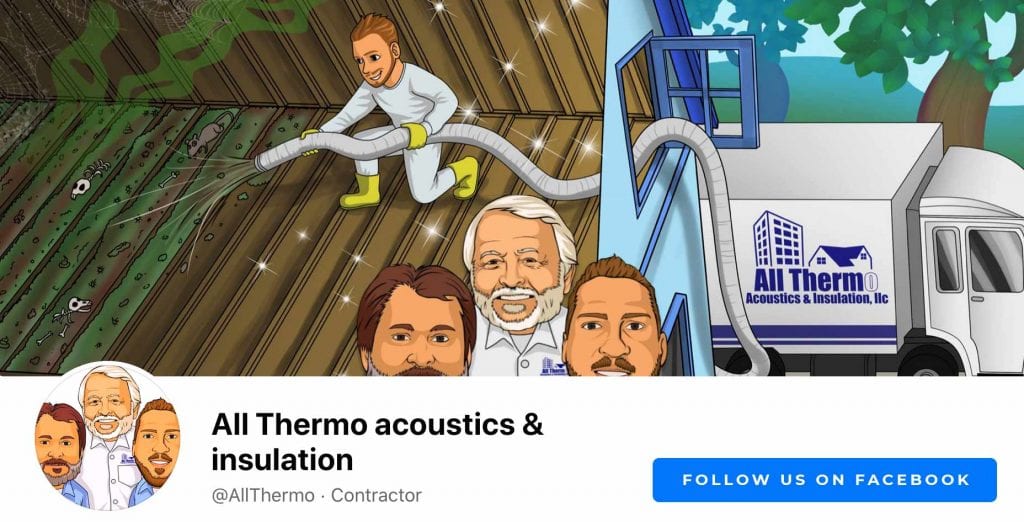Insulation Removal
EXCELLENTTrustindex verifies that the original source of the review is Google. I was impressed with their work and their work ethic. They worked hard blowing installation into the attic, it took longer than they expected, then they explained to me all that they had done. I would recommend this company!Trustindex verifies that the original source of the review is Google. Jason and his team did a great job. Everyday when they left you could not even tell they were there. They cleaned up and left everything spotless. I highly recommend them.Trustindex verifies that the original source of the review is Google. Very attentive and quick response ! Neat clean job - very efficient and on time- everything we expected- good service! Thank you Jason Christian and your team!Trustindex verifies that the original source of the review is Google. Great family run business in Jupiter. Have used these guys a couple of times now for different properties and would highly recommend. They are thorough, neat and provide pictures at the end to prove their work. Also had them seal all my ducts and ventilation fans. House is cooler and allows my A/C to run more efficiently as well! Attached some before and after pics. Give them a call!Trustindex verifies that the original source of the review is Google. I am so happy with our newly updated insulation with All Thermo. They came out to estimate and I am so glad they did the job for us. Very knowledgeable and they taught me a lot I didn't know about attic insulation. The team is on time and friendly and very clean. They cleaned themselves right out of the driveway as they loaded up to continue to the next job. Thank you so much All Thermo and team.Trustindex verifies that the original source of the review is Google. We recently had full ductwork and insulation replacement done throughout our home, and I can’t say enough good things about the team. From start to finish, they were extremely communicative, keeping us informed every step of the way and making sure we felt confident in the process. Their crew was highly professional, respectful of our home, and worked with impressive efficiency. Not only did they complete the entire project ahead of schedule, but they also went above and beyond to make sure everything was done to the highest standard. It’s rare to find a company that combines quality work, strong communication, and exceptional customer service — but this team delivered on all fronts. Highly recommend! Thank you again Jason & Christian!Trustindex verifies that the original source of the review is Google. All Thermo did a great job insulating my attic. Christian explained what they would do and how it should make a difference with my HVAC system. I appreciate the honest communication and not trying to be upsold. The team arrived on time and cleaned up after everything was done. I would certainly recommend All Thermo to help keep your house cool during the hot summer.Trustindex verifies that the original source of the review is Google. I thought I needed a new HVAC and almost shelled out 20k. It occurred to me the inefficient cooling was from poor insulation. The quote was more than I expected but my home is actually cool now. It was far cheaper to get my attic insulated than replace my HVAC. My bills have been $80 less compared to this time last year.Trustindex verifies that the original source of the review is Google. Great work and fast scheduling. Would recommendTrustindex verifies that the original source of the review is Google. Tired of the high electricity bills but frustrated with the struggle to find good (contractors) help in South Florida…we were on the fence about whether or not to get the attic insulated. Then Christian from AllThermo came by after a recommendation from two neighbors. His (and Jason’s) communication was excellent and after crawling around in our attic, they were able to explain what we needed and answer the questions we had. Overall, wonderful experience only to be solidified by the following data…a week just prior to the insulation compared to a week after the insulation, we can see that the AC ran 50% of the time. Of course, there are other variables (weather) but the weeks were similar and we will continue to monitor. If you are even considering it, give Christian and Jason a call…they will talk though your thoughts and questions looking to do what’s right for your situation
How to Remove Insulation From Attic: The [Complete]Guide to attic insulation removal cost

Introduction to Attic Insulation Removal
Understanding the Importance of Insulation Removal
We’re here to guide you through the process of attic insulation. Just like decayed teeth, old insulation can be a nightmare for your home’s maintenance. [Stat: Up to 50% of energy loss is due to poor attic insulation.]
Why Does Insulation Need to Be Removed?
Every so often, insulation needs removal. The culprits? Age, deterioration, or damage from water, pests, or mold. In some cases, hazardous types of insulation might endanger your [family’s health]. Electricity bills climbing steeper than Everest? This could be due to poor insulation as well.
[“We have embraced the 21st century by entering such cutting-edge industries as brick, carpet, insulation and paint. Try to control your excitement.” – Warren Buffet]
Types of Insulation and Its Removal Methods
How to Remove Blown-In Insulation
With our step-by-step guide, removing blown-in insulation is like a walk in the park.
- Set up your gear and equipment nearby for easy access.
- Clear your path from the attic entry to the front door and cover it with a protective layer.
- Get your ladder, commercial vacuum, and other tools ready in the attic.
- Protective outfit on? Great! Start that vacuum and rake in that insulation into waste bags.
- Repeat till every nook is insulation-free.
- Dispose of the waste responsibly and clean the zone.
- The result? A sparkling clean attic, safe and sound.
Fiberglass Batt Insulation Removal
Who knew removing fiberglass batt insulation could be this simple?
- Put on your safety gear first, always!
- Find the insulation edges with your trusty utility knife or scissors.
- Cut the insulation into manageable chunks.
- Pull it out gently to avoid unnecessary mess, collecting the clumps into plastic bags.
- Tidy up the room from any lingering fibers or debris.
- Essential tip: Old insulation is a fire hazard, dispose of it properly.
- And voila, your attic is fiberglass insulation-free!

Vacuuming Cellulose Insulation Removal
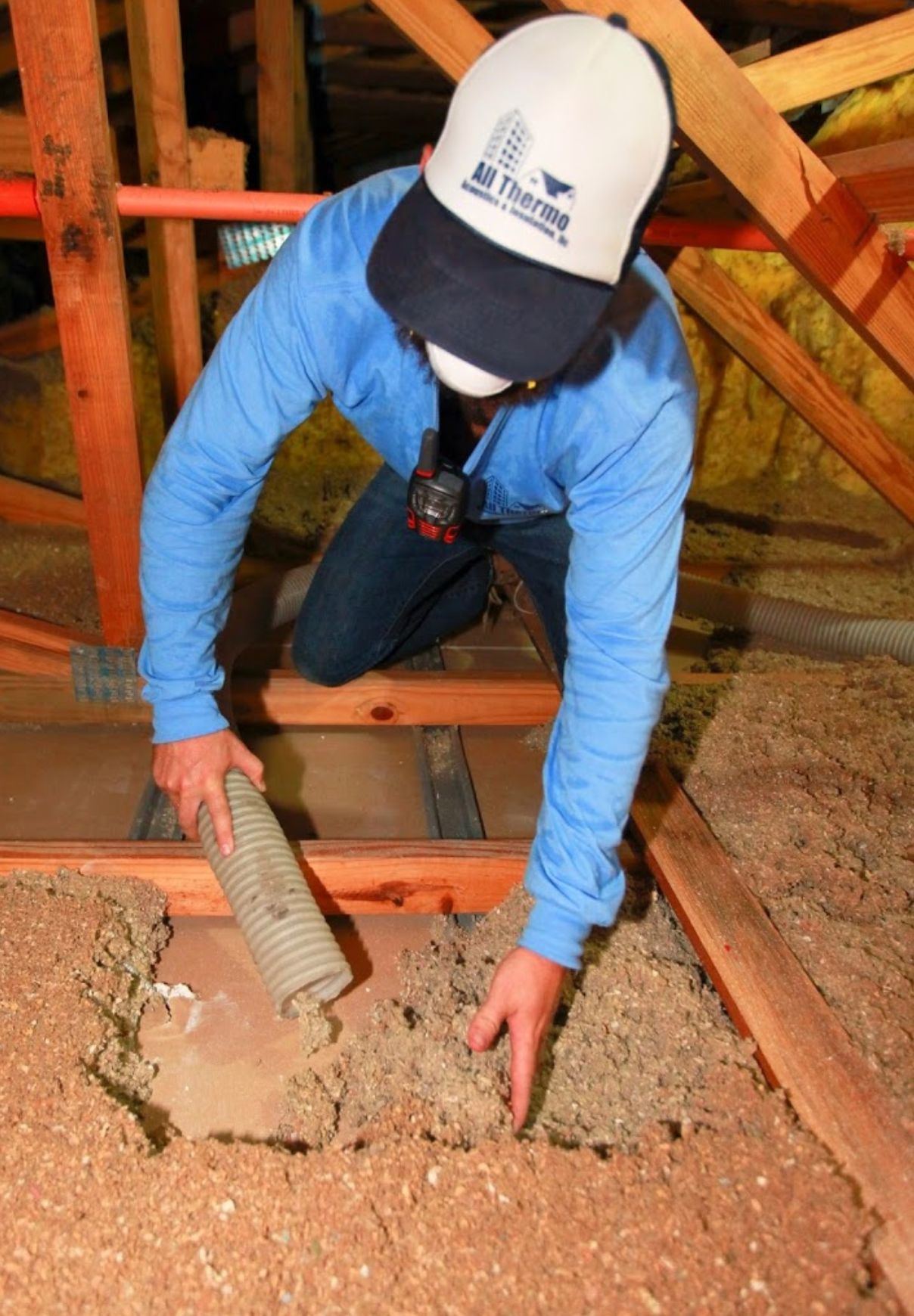
Got cellulose insulation stuck in your attic? Here’s how to wave it goodbye:
- Safety gear on! Don’t forget your gloves, mask, and eyewear.
- Turn on your deep-suction vacuum, and let it do the tough job.
- Gather the cellulose into bags. Don’t forget to squeeze out the excess air!
- Discard the waste, giving your attic a vacuum once-over.
- And, there you go! Your attic is free of cellulose. Remember how it looks! [“For more than four decades, we have effectively removed cellulose insulation and its harsh chemicals to provide homeowners with improved air quality.”. – All Thermo]
Reasons for Insulation Removal
Removal Due to Hazardous Types of Insulation
What’s scarier, ghost stories, or harmful insulation in your attic?
Some old houses are unlucky to have asbestos-based vermiculite insulation, which can spread airborne asbestos during removal. If your house was built before 1990, you might find carcinogens-laden Balsamic wool there too.
Fear not, professional help is available! They can test your attic and take necessary actions. Remember, your health is your wealth. Ask experts for help when in doubt.
Insulation Removal Due to Water Damage or Mold
When moisture sneaks into your insulation, mold promptly follows suit. This unwelcome guest can cause headaches and other health problems, not to mention it can wreck your insulation’s function. [Fact: Mold in insulation can double energy loss.]
Similarly, water damage from leaks can cause mold growth or soggy insulation, which can then bring down the roof. So keep your eyes peeled for leaks or moldy patches. Safety and efficiency always come together.
Removal Due to Pest-Infested Insulation
Unwanted guests in your attic? Rodents, birds, insects—they’re all notorious for turning insulation into a nest, a bathroom, or a buffet. Result? Contaminated and inefficient insulation that’s bad for both your pocket and health. [Quote: “It’s like living with an enemy in your own house.” – John G. – West Palm Beach, FL]
If you spot droppings or nests, proceed with caution. Call in the experts to say goodbye to pests and tainted insulation.
Removal Due to Damaged or Sagged Ceilings
Can your house bear the weight of old, heavy insulation? Once your ceiling starts to sag or cracks visibly, it’s a telltale sign that your insulation’s gotta go.
Replacing the insulation and fixing the dented ceiling would save your house from possible structural damage or worse – an unwelcome collapse. [Statistic: 1 in every 50 homes experience serious structural damage due to neglected insulation.]
Remember, safety first, always. Don’t overlook warning signs when they show up.
Safety Precautions During Insulation Removal
Suitable Protective Gear during Insulation Removal
Scared of attic bogeymen? Ward them off with your safety gear. This ensemble includes:
- Gloves to fend off any harmful materials. The best? Rubber-coated ones.
- A mask, ideally 95-rated, to keep your lungs dust-free.
- Reliable eyewear to keep your eyes safe. Anti-fog coated goggles are a clear winner!
- Definitely coveralls, to safeguard your skin, preferably hooded.
- Don’t forget a sturdy hat for your tall folks out there. Attics can be surprisingly low.
- Lastly, a headlamp, because your hands are for work, not for holding flashlights.
With this arsenal, you’re more than prepared to brave the attic.
How to Handle Hazardous Insulation Materials
Found a suspicious material in your attic? Don’t play the guessing game. Undisturbed asbestos is harmless, but meddling with it spreads hazardous fibers.
Your first step? Air on the side of caution. Second, call in certified asbestos abatement professionals. Let us handle the risks, so you can rest easy.
Lastly, isolate the area and keep the kids and pets away. Remember, your safety is paramount.
What Next? Post Insulation Removal Measures
Cleaning Up After Insulation Removal
Once the old insulation’s out, it’s time to clean up like a pro.
- Wet/dry or HEPA vacuum out any lingering dust or particles.
- Spray disinfectant for a deep clean.
- Wipe down all surfaces with a damp cloth.
- Bag all the disposable protective gear and throw it away safely.
- Queue shower time – you’ve earned it!
Doing a thorough cleanup ensures your new insulation has a clean slate to start with. [Important note: Old insulation and gear are fire hazards! Dispose of them responsibly.]
When and How to Install New Insulation
After cleaning up post your insulation eviction, it’s time for the new star – fresh insulation!
What’s the right time to install? ASAP is your best bet. Delay could compromise your home’s temperature control, leading to higher energy costs.
As for the ‘How’, it depends on the insulation type. Something like blown-in insulation requires a professional blower. Batt insulation, on the other hand, is a simple unroll and place job.
When in doubt, call in a professional. They can assess your situation and offer the best solution tailored to your needs.
[Case study: Below are images depicting toxic cellulose insulation (brown/grey paper insulation) that was installed by a recently new franchise company in a homeowner’s attic. The homeowner became so sick from the material that he had to move out of his home. After trying to reach this new insulation company for several days and receiving no call backs, they reluctantly agreed to remove the chemical insulation. However, they did a very poor job and mainly just blew new insulation over the cellulose insulation. Due to their inadequate removal process, the homeowner was still unable to live in his home.
We stepped in and removed all the insulation, sanitized the entire attic, air sealed the attic floor, and adjusted the attic air pressure to ensure it wouldn’t be drawn into the living space. After completing these steps, we insulated the home with chemical-free insulation so the homeowner could finally move back in.
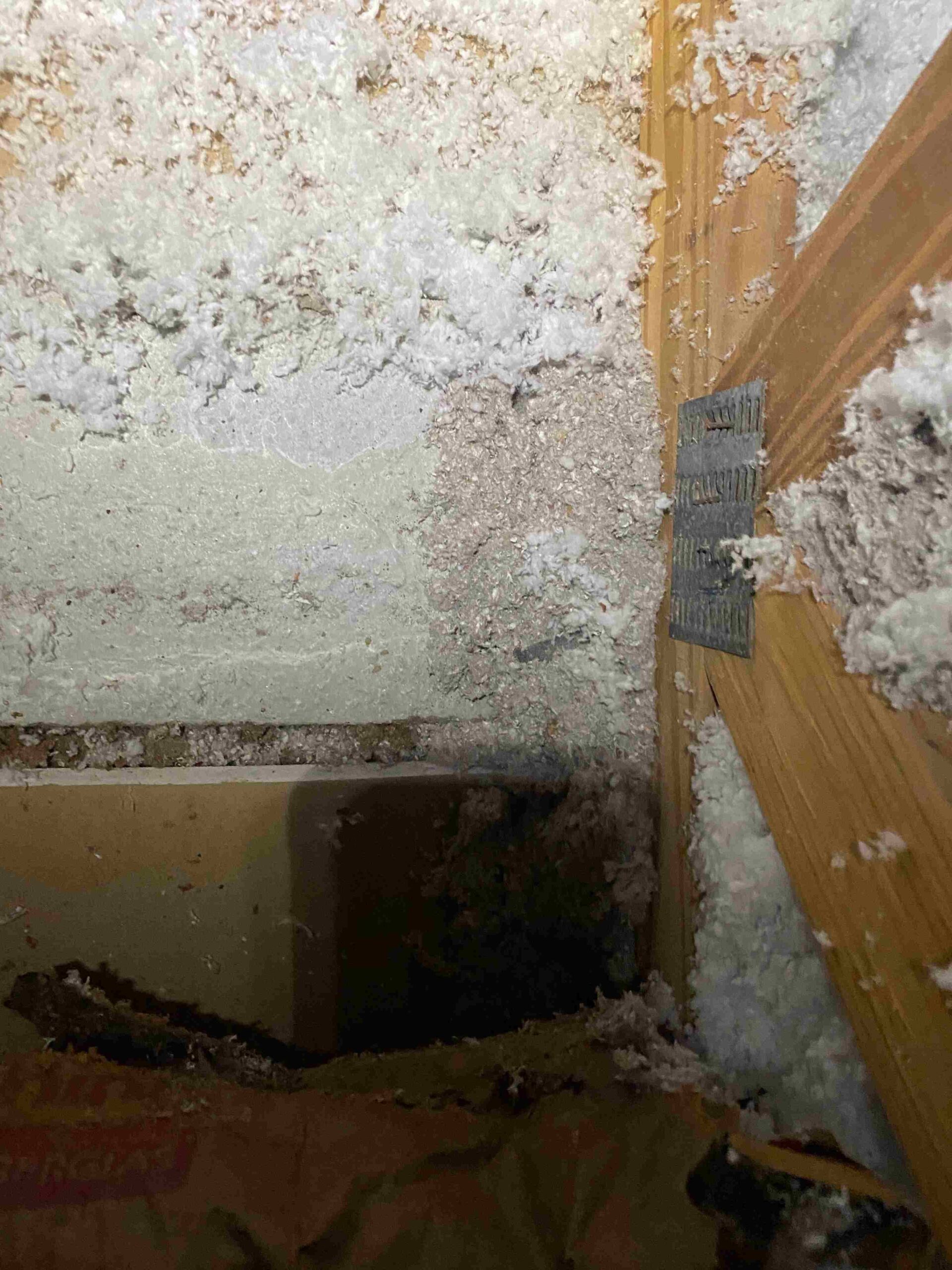
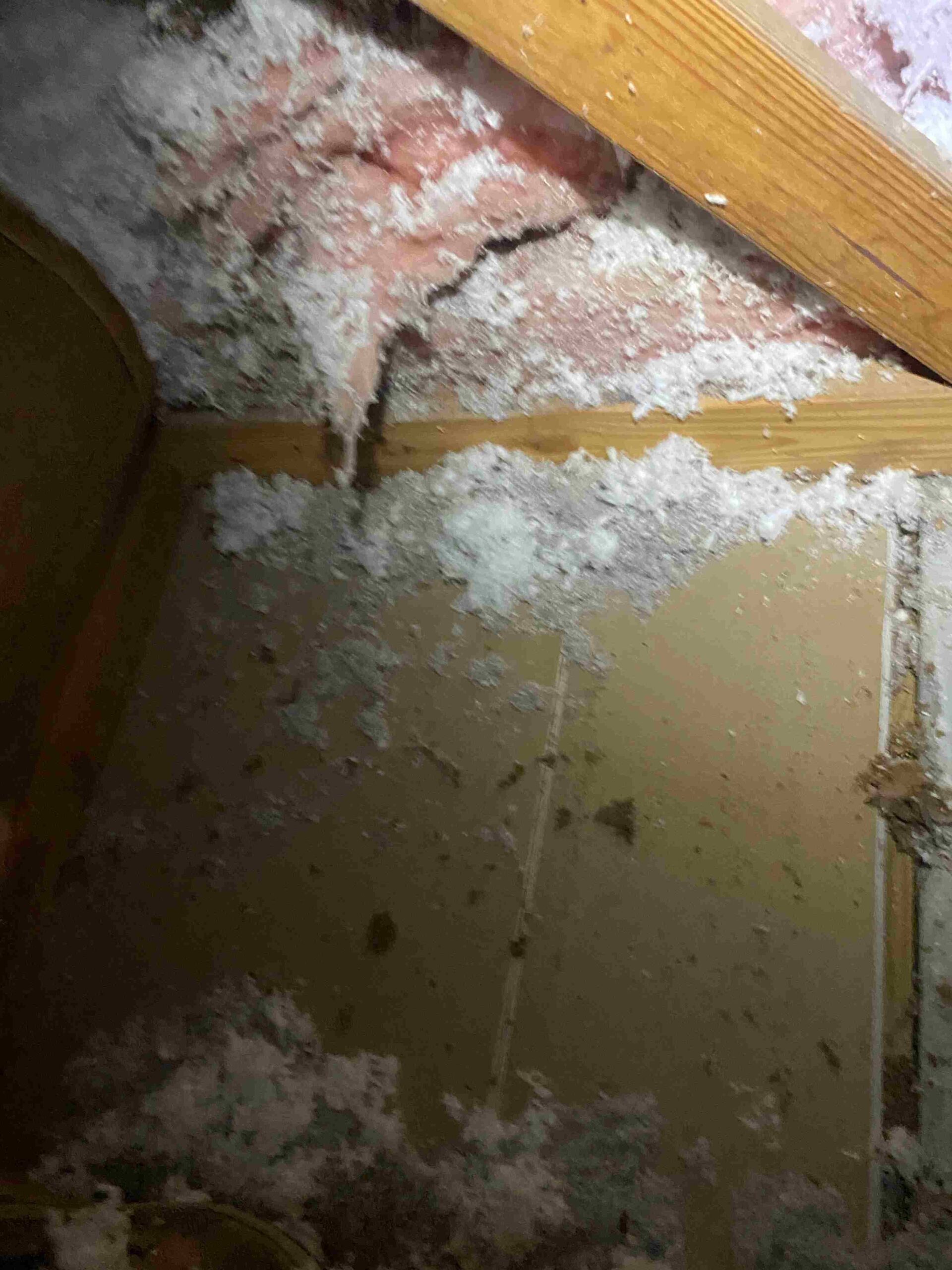
After discovering faulty insulation, one of our customers was forced to vacate their homes. However, we remedied the situation by removing the previously installed insulation from another company and successfully facilitated the return of our customers to their residences. [“You gave me my life back” – Customer – Stuart, FL]
Cost Implications of Attic Insulation Removal
How much does Insulation Removal cost?
How much does insulation removal cost? The magic number can be around $2,500 on average. The range typically falls between $1,000 and $4,000, depending on the complexity and size of the project.
Tackling a 1,500-square-foot attic? You may be looking at anywhere from $2,000 to $3,000. But DIY can trim down that cost to roughly $1,000 to $1,500. Remember, a thorough approach can save you a pretty penny.
The best way to estimate your attic insulation removal cost is to call in a professional for an accurate quotation. They’ll evaluate the type of insulation, the extent of contamination, the ease of access, and your local labor rates.
Factors that Influence the Cost of Insulation Removal
Wondering what drives insulation removal costs up or down?
- Attic Square Foot Size: Bigger the attic, the higher the price.
- Insulation Type: Blown-in insulation is tougher to remove than batts, hence pricier.
- Encapsulation: Moldy or hazardous insulation could require encapsulation or sealing, which costs extra.
- Accessibility: Easy access attics generally save you money as opposed to cramped spaces. (can we stand or do we have to crawl?)
- Local Rates: Your geographic location can impact the labor costs involved.
Your specific quote will give you the right number. Always request for a detailed breakdown.
DIY vs. Hiring a Pro: Making the Choice
Risks and Challenges of DIY Insulation Removal
Thinking of donning the DIY superhero cape for insulation removal? Beware, it comes with risks.
- Health hazards: Unprotected exposure to insulation can lead to respiratory issues or harmful infections.
- Mistaken materials: You could unknowingly mess with asbestos or mold, endangering your health.
- Incomplete removal: Bits of insulation could be left behind, reducing the effectiveness of new insulation.
- Accidental damage: DIYers might accidentally tread on the wrong spot, triggering a ceiling collapse.
Long story short? When in doubt, opt for safety over savings! [Statistic: According to the National Safety Council (NSC) there are over 200,000 DIYer accidents per year.]
Advantages of Hiring a Professional Service
Why hire us for insulation removal? Here’s why:
- We say YES to safety: We take precautions to heart, keeping mishaps at bay.
- Trained eyes: We’ll spot and handle hazardous materials with skill and care.
- Comprehensive cleanup: Our team leaves nothing behind. No hint of old insulation, no mess at all!
- Efficient installation: We know insulation in and out. When we install the new, it’s done with expertise for optimal results.
- Time saved: Say goodbye to days of DIY struggle. We’ll have it done before you know it.
So give yourself the gift of peace, safety, and efficiency.
[“All Thermo was very professional, and a great company to work with. In particular, they were prompt and met all of our expectations with our insulation project. They removed our old insulation, sanitized, and air seal before installing fresh insulation. Equally important, they kept the work area clean.” – Leanna L. – West Palm Beach, FL]
Contact Us Today!
Schedule Your Free Insulation Evaluation
Keen on a hassle-free insulation evaluation? We’ve got it covered. Just call us on 602-499-2922 or click [here] to schedule an attic inspection. Trust us to give you the rundown on what’s needed for your home. No hidden costs, only honest work.
[I’m the type of person that researches companies and asks tons of questions before making a decision to use them. I would highly recommend All Thermo!!! From the quoting process to the end of installation they were attentive, extremely professional and knowledgeable. If I could give another star, I would!!! – Mark C. – West Palm Beach, FL ]
Get an Instant Quote for Insulation Removal Services
Ready to wave old insulation goodbye? Get an instant quote now! Just provide your name, phone number, zip, and services needed on our website or call us at 561-842-3336. We ensure quick, quality service that fits your budget.
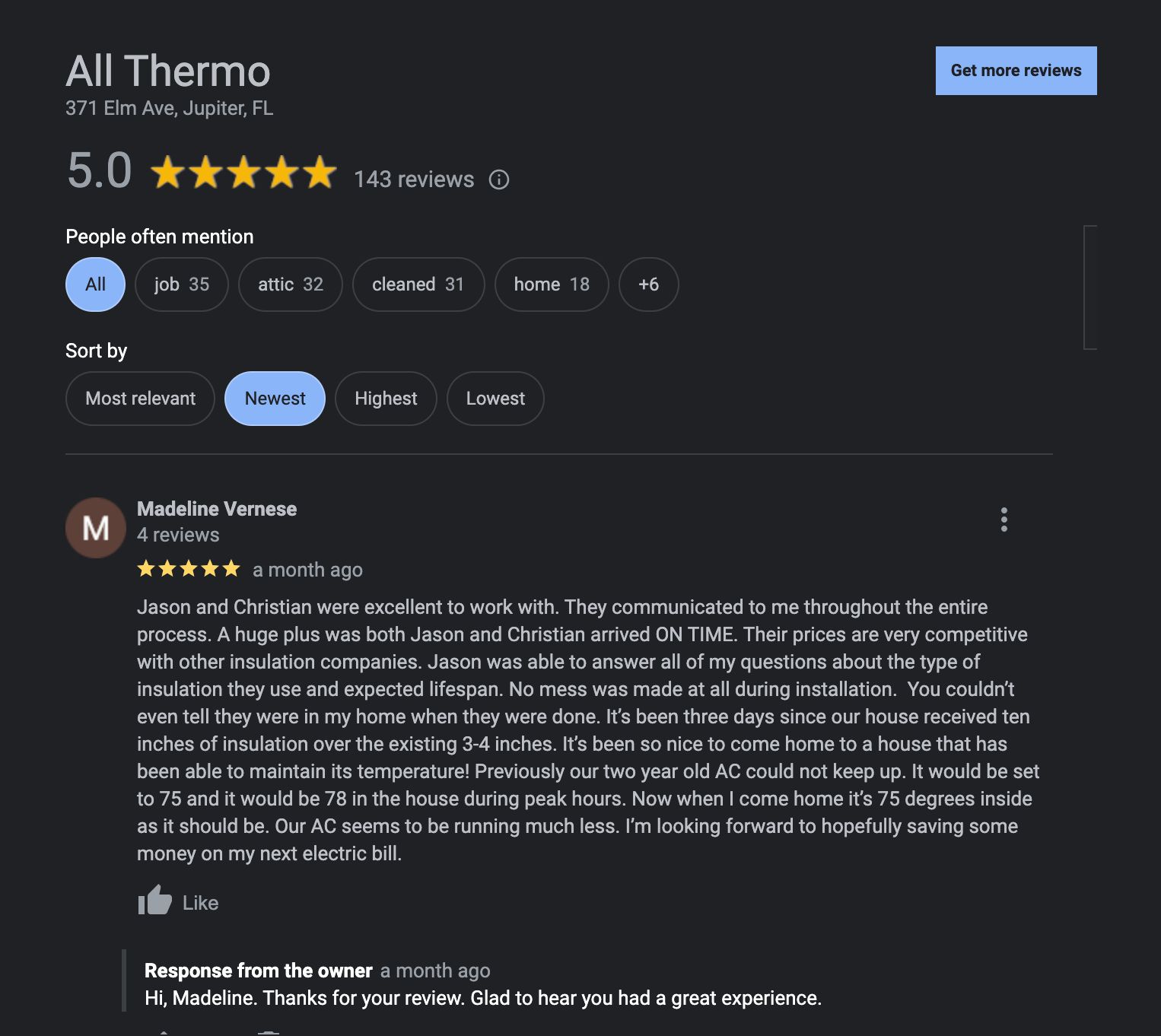
With All Thermo Insulation, getting your attic clean and energy-efficient has never been simpler.
Frequently Asked Questions (FAQs)
How long does Insulation Removal Take?
Typically, a well-equipped professional team takes about 4-6 hours to remove attic insulation from an approximately 1,500 square feet space. If you’re into DIY, this can range anywhere between 2-3 days, depending on attic conditions and your pace. It’s best to plan for removal over several days or even weekends to ensure a thorough job.
Does All Old Insulation Require Removal?
Nope, not all old insulation warrants removal. If your attic insulation is still effective and isn’t contaminated by mold, water, or pests, you can often leave it be. Sometimes, adding new insulation on top of the old is all you need for a cozy, energy-efficient home. However, it’s always wise to get a professional opinion to be sure. Safety first, costs second.
Lifespan of Attic Insulation
Understanding the lifespan of your attic insulation is crucial for maintaining energy efficiency and comfort in your home. Different types of insulation materials come with varied life expectancies, depending on their composition, quality, and environmental conditions.
Lifespan Information for Different Types of Attic Insulation
The lifespan of insulation depends largely on the material used. Here’s a breakdown of common attic insulation types and their average lifespans:
-
Fiberglass Insulation
- Lifespan: 80–100 years
- Details: Fiberglass is highly durable and can last decades when undisturbed. However, it may settle or degrade over time if exposed to moisture or pests.
-
Cellulose Insulation
- Lifespan: 20–30 years
- Details: Made from recycled paper, cellulose has a shorter lifespan and can degrade quicker due to moisture absorption and natural settling.
-
Spray Foam Insulation
- Lifespan: 50–80 years
- Details: Spray foam insulation has a long lifespan and excellent sealing properties. However, physical damage or improper installation can reduce its effectiveness.
-
Mineral Wool Insulation
- Lifespan: 30–50 years
- Details: Known for its fire resistance and durability, mineral wool offers longevity but may settle or compress over time.
Conditions That Affect Insulation Lifespan
Several factors can influence how long your attic insulation lasts and how effectively it performs:
-
Moisture
- Water damage can cause insulation to lose its R-value, the measure of thermal resistance. Fiberglass and cellulose are particularly susceptible to mold and degradation when exposed to moisture.
-
Pest Infestations
- Rodents and insects can nest in attic insulation, compromising its structure and effectiveness. Cellulose and fiberglass insulation are most vulnerable to pest damage.
-
Physical Damage
- Construction activities, roof leaks, or wear and tear can compress and displace insulation, reducing its performance.
-
Settling
- Over time, certain insulation types, such as cellulose, may settle, decreasing their ability to trap air and provide proper insulation.
Guidelines on When to Replace Insulation
To maintain optimal energy efficiency and home comfort, homeowners should inspect attic insulation regularly and consider replacement under the following conditions:
- Age:
- Fiberglass insulation older than 80 years or cellulose insulation over 20–30 years may no longer perform effectively.
- Signs of Moisture:
- Stains, mold, or damp insulation indicate water damage and require immediate attention.
- Visible Damage:
- Compressed, displaced, or torn insulation cannot provide sufficient thermal resistance and should be replaced.
- Increased Energy Bills:
- If heating or cooling costs rise unexpectedly, aging or degraded insulation may be the cause.
- Pest Infestation:
- Evidence of nesting or droppings suggests compromised insulation that should be replaced after addressing the pest issue.
Maintaining and Extending Insulation Lifespan
To prolong the life of your attic insulation:
- Fix roof leaks promptly to prevent moisture buildup.
- Conduct annual inspections to check for damage or settling.
- Keep the attic sealed to prevent pest access.
- Avoid unnecessary physical contact during renovations or maintenance.
By understanding the lifespan of attic insulation and addressing factors that cause degradation, homeowners can make informed decisions about when to replace their insulation. This ensures energy efficiency, lower utility bills, and a comfortable living environment.


